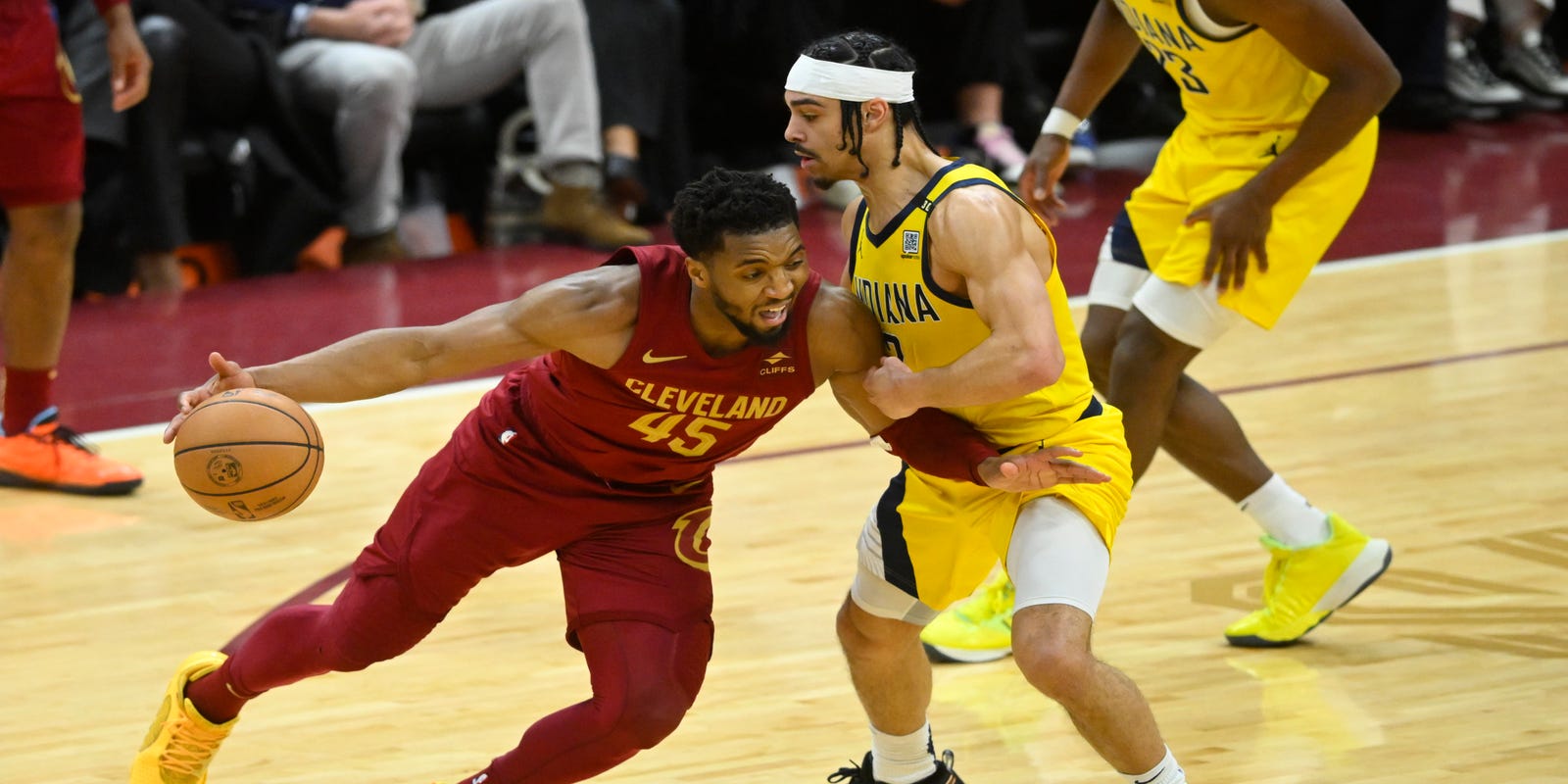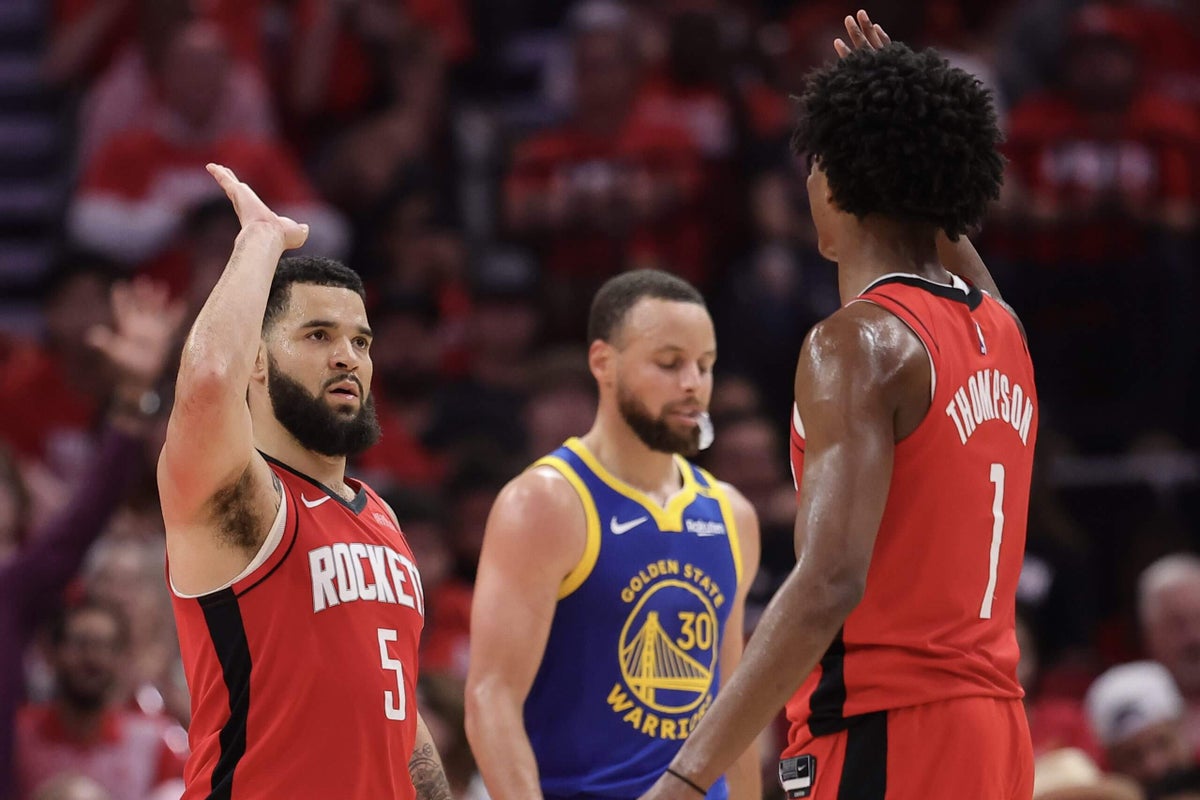
INDIANAPOLIS — The Pacers survived their first-round series despite having to deal with one of the best players in the world, but now they have to deal with the team that produced the most 2025 NBA All-Stars.
No. 4 seed Indiana took down the No. 5 seed Bucks in spite of a seminal performance from Giannis Antetokounmpo whose 33.0 points (on 60.6% shooting) and 15.4 rebounds per game in the series are the most for any player so far in the 2025 playoffs. In the No. 1 seed Cavs, however, the Pacers will see a team with much more balance and not only one of the best starting fives in the NBA but also one of the strongest benches. They finished the season 64-18, posting not only the best record in the Eastern Conference but the second-best record in Cavaliers franchise history, becoming the first Cleveland team without LeBron James to win 60 games.
The Cavs boast the Defensive Player of the Year (Evan Mobley) a possible first-team All-NBA pick (Donovan Mitchell) a third All-Star (Darius Garland) and a Sixth Man of the Year finalist (Ty Jerome). They also have the NBA’s leader in field goal percentage (Jarrett Allen) and one of the most important trade deadline acquisitions in the league (De’Andre Hunter).
But the Pacers obviously have two All-Stars themselves in Tyrese Haliburton and Pascal SIakam, who have four appearances and three All-NBA selections between them. The Pacers also have almost every important piece from last year’s Eastern Conference finals run. The Cavaliers will certainly be the favorite in the series, but the Pacers do have a comparable level of firepower, enough for the Cavaliers to know they’re dangerous.
Here’s how the two teams matchup, position by position.
Point guard
Tyrese Haliburton vs. Darius Garland
Haliburton’s season has had its peaks and valleys, but his turnaround after the season’s first month was arguably the biggest reason the Pacers went 40-17 in the season’s final 57 games. His first-round performance against the Bucks wasn’t spectacular from end-to-end either, but his buckets at the end of the Game 5 are the reason the Pacers were able to close it out.
The two-time All-Star point guard started the season playing some of the worst basketball of his life, shooting 37.5% from the floor and 28.4% from 3-point range over the first 15 games. In his last 58, however, he averaged 19.5 points per game on 49.9% shooting including 41.5% from 3-point range and 9.4 assists per game against 1.6 turnovers. After the All-Star break he was even better, averaging 20.3 points per game on 53.3% shooting and 43.9% 3-point shooting, 11.0 assists, 1.2 turnovers and 1.8 steals. For the season, he led all NBA players with more than 50 games in assist-to-turnover ratio at 5.61.
Haliburton’s first-round shooting numbers weren’t as good as he scored 17.6 points per game on 42.1% shooting including 26.8% from 3-point range, but he averaged 11.6 assists against 2.2 turnovers per game and, of course, he scored six straight points to end regulation in Game 5 and force overtime and then five straight to close OT including a game-winner. Counting both regular season and postseason games, he’s posted double-figure assists in 21 of his past 25 games.
Darius Garland didn’t finish the season nearly as well as he started it. Before the All-Star break, he averaged 21.6 points per game on 49.8% shooting including 43.1% from 3-point range. After, he averaged 18.2 per game on 41.3% shooting and 33.5% from 3. Still, the 6-1, 192-pound Gary native got back to the All-Star Game for the first time since 2021-22 and had his most efficient season in the NBA, scoring 20.6 points per game with career highs in field goal percentage (.472) and effective field goal percentage (.562) while leading the Cavs with 5.6 per game. He also made an impact on defense with 1.2 steals per game. Garland is dealing with a toe injury and missed the last two games of the series with the Heat, but he scored 27 points in Game 1 and 21 in Game 2.
Haliburton almost certainly won’t be defending Garland to start games and will most likely be assigned to Max Strus. Garland could defend Haliburton but could also begin the game on Andrew Nembhard.
Advantage: Pacers
Shooting guard
Andrew Nembhard vs. Donovan Mitchell
Andrew Nembhard is once again proving the postseason suits him well with offensive numbers significantly better in the playoffs than he had in the regular season. The Pacers’ third-year guard averaged 14.9 points per game in last year’s playoffs after posting 9.2 per game in the regular season, and this year the gap is nearly as big. In the series against the Bucks he averaged 15.0 per game after scoring a career-high 10.0 points per game in the regular season.
There’s an even more dramatic gap in his shooting figures. The defensive burden Nembhard had to carry all season seemed to take a toll on his legs late in the year and he scored double figures in just four of the season’s last 13 games. He was 3-of-23 from the floor in the season’s last three games and 1-of-15 from 3 in the last five, pulling his season field goal percentage down to .458 and his season 3-point percentage down to .291. He never hit more than two 3-pointers in a game all season and didn’t hit more than one in a game after March 19.
Against the Bucks, however, he scored double figures in four of five games, shot 49.2% from the floor and made 11-of-22 3-pointers (50%). He hit at least three 3-pointers in three games and made 7-of-13 combined in Games 4 and 5. And just as he had all season, he frustrated Bucks players with full-court on-ball pressure, grabbing seven steals after averaging a career-best 1.2 steals per game in the regular season and earning Eastern Conference Defensive Player of the Month honors in January.
Donovan Mitchell, of course, has been a strong playoff performer throughout his career going back to his time with the Jazz and his sensational performance in the 2020 COVID bubble playoffs when he averaged 36.3 points per game in a seven-game thriller against the Nuggets. He didn’t have to do much in the Heat series, playing just 30.8 minutes per game, but he scored 23.8 points per game on 47.8% shooting including 45.7% from 3-point range.
The 6-3, 215-pound Mitchell may be the NBA’s best true shooting guard and has a chance to get the last first-team All-NBA spot with Antetokounmpo, Oklahoma City’s Shai Gilgeous-Alexander, Denver’s Nikola Jokic and Boston’s Jayson Tatum being four locks for the squad. He averaged 24.0 points per game on 44.3% shooting including 36.8% from 3-point range, right around his career averages over his eight seasons. He finished 17th in the league in total points, 19th in total field goals, 12th in 3-pointers and 19th in free throws. He has a powerful frame and can get to the rim whenever he wants but can also score at all possible levels.
Nembhard could guard Mitchell or Garland. Mitchell could guard Haliburton, Nembhard or Aaron Nesmith.
Advantage: Cavs
Small forward
Aaron Nesmith vs. Max Strus
Aaron Nesmith lost almost a half a season to a severe ankle sprain, missing 35 games from Nov. 1 to Jan. 16 and he spent the rest of the pre-All-Star period finding his legs, his lungs and his rhythm. But since the break he’s been excellent, and in the playoffs so far he’s been spectacular.
The 6-6, 215-pound warrior averaged 15.0 points per game on 52.2% shooting and 45.3% 3-point shooting after the All-Star break. In the first round against the Bucks he averaged 14.8 points per game on 53.8% shooting and 51.9% 3-point shooting and also grabbed 6.4 rebounds per game after posting 4.0 per game in the regular season. His chase-down block on Bobby Portis in Game 4 was one of the most important plays of the series, and he finished with 19 points and 12 rebounds in Game 5.
With two guards who can be occasionally be ball-dominant and two 6-11 bigs, Strus fits in with the Cavaliers’ starting lineup as a necessary floor-spacing shooter. This season, 78.5% of his field goal attempts were 3-pointers and he hit 113 in 50 games, 38.6% of those attempts.
Advantage: Pacers
Power forward
Pascal Siakam vs. Evan Mobley
Pascal Siakam has been set-your-watch reliable since the Pacers acquired him from the Raptors in January of 2024.
In 119 regular season games and 22 playoff games in an Indiana uniform, he’s been held under double-figure scoring just twice. He led the Pacers in scoring in his half-season in 2024 with 21.3 points per game, in last year year’s playoffs with 21.6 points per game, in the 2024-25 regular season with 20.2 points per game and in the Bucks series with 19.8 points per game.
The 6-8, 245-pounder fits perfectly in the Pacers’ uptempo system of randomized chaos as a rim finisher in transition, cutter and catch-and-shoot 3-point option and he’s also dynamite in transition especially in wing post-ups. He shot 51.9% from the floor and a career-best 38.6% from 3-point range in the regular season and made 55.6% of his field goals and 44.4% of his 3s against the Bucks. He also led the Pacers with 6.9 rebounds per game in the regular season and stepped up on the defensive end, picking up full court and averaging 0.9 steals per game.
Mobley’s leap was a big part of what took the Cavs from being an also-ran playoff team in 2023-24 to a title contender this season. New coach Kenny Atkinson encouraged Mobley to expand his perimeter game, trusting him to handle the ball beyond the 3-point arc and shoot from outside and that unlocked a new level to his offensive game. He scored a career-high 18.5 points per game on 55.7% shooting and 37.0% 3-point shooting. After making 67 3-pointers combined in his first three seasons, he made 85 this year.
Meanwhile on the defensive end, Mobley became even more of a force than he already was. He grabbed 9.3 rebounds per game, blocked 1.6 shots per game and averaged 0.9 steals per game, showing that he could rim-protect, rebound and be trusted to defend in space.
Advantage: Cavs
Center
Myles Turner vs. Jarrett Allen
Myles Turner continues to make a strong case for a new contract with his two-year deal running out at the end of this season. The 10th-year veteran saw his scoring numbers dip slightly down to 15.6 points per game, but he shot a career-best 39.6% from 3-point range with 156 3-pointers, 40 more than he hit in any season in his career.
Even as a 5 man, Turner is a three-level scorer. He made 55.9% of his 10-16 foot jumpers and 49% of his jumpers from 16 feet to the 3-point line this season. He can also pass out of shot rolls and his versatility in ball screen actions makes him a perfect partner for Haliburton. The Pacers’ all-time leading shot-blocker also averaged 2.0 blocks per game this season, which ranked fifth among all players, third among players with at least 50 games and first among players with at least 65. His 144 total blocks were third behind San Antonio’s Victor Wembanyama and Milwaukee’s Brook Lopez.
Turner averaged 16.8 points per game on 50.9% shooting and 2.2 blocks per game against the Bucks. After an ugly performance in Game 3, he scored 23 points with four blocks in Game 4 and had 21 points and nine rebounds in Game 5.
Though the Cavs have played with more pace and more wide open style under Kenny Atkinson, Jarrett Allen has still made an impact with almost all of his scoring has come near the basket. He averaged 13.5 points per game led the NBA in field goal percentage, putting in 70.6% of his attempts. According to Basketball Reference, 59.4% of his attempts came within 3 feet of the basket and another 34.2% came from 3-10 feet so just 6.4% came from further out, but he made 81.3% of his shots within 3 feet and 58.4% of his shots from 3-10. He also averaged 9.7 rebounds, 0.9 blocks and 0.9 steals per game to make an impact on defense.
In the first round against the Heat, Allen averaged 14.3 points and 10.3 rebounds per game, made 77.8% of his field goals and all 15 of his free throws.
Advantage: Pacers
Bench
The Pacers leaned heavily on their bench in the first round to maintain the necessary stamina to bring constant full-court man-to-man pressure on ball-handlers, using a rotation that eventually included 11 men. Point guard T.J. McConnell, wing Bennedict Mathurin and forward Obi Toppin have been the staples and Thomas Bryant has stepped in at center but second-year wings Jarace Walker and Ben Sheppard have given them more defensive options. Walker gave them a big-bodied option who would bring force to a matchup with Giannis Antetokounmpo while Sheppard gave them a speedier option to chase around guards.
McConnell saw his numbers tick down across the board after a career-year in 2023-24, but he still averaged 9.1 points per game on 51.9% shooting and 4.4 assists per game. He finished 11th in the NBA in total points off the bench and first in total assists off the bench with 348. Toppin finished seventh in total bench points with 766 and Mathurin averaged 16.1 points per game, starting 49 games though he was eventually moved onto the bench for Nesmith.
The Pacers’ bench averaged 39.8 points per game in the regular season to the Cavs’ 39.7 per game and they led the league in bench field goal percentage at 49.6% while the Cavs were ninth in the category. However, point guard Ty Jerome and wing De’Andre Hunter both ranked in the top six in the league in bench scoring and were two of the most effective reserves in the league. Jerome had a career year with 12.5 points per game on 51.6% shooting including 43.9% from 3-point range. Hunter averaged 17.0 points per game on 47% shooting including 40.5% from 3-point range combined in his time with the Cavs and Hawks. Guard Sam Merrill hit 137 3-pointers mostly off the bench and forwards Dean Wade and Isaac Okoro give them two bigger bodies that can serve as wing defenders.
Advantage: Cavs
Get IndyStar’s Pacers coverage sent directly to your inbox with the Pacers Update newsletter.


